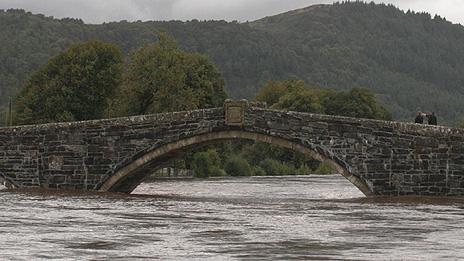Migrating birds rescued at Newgale after high winds
- Published
Hundreds of seabirds were left stranded on the coast after being blown off course as high winds and heavy rain cause disruption in parts of Wales.
The RSPCA rescued the Manx shearwaters, which were migrating to Argentina from their burrows on Skomer island off Pembrokeshire.
More than 400 ended up on cliffs and in the surf at Newgale in Pembrokeshire.
The charity said it was the biggest bird rescue in the area since the Sea Empress oil spill in 1996.
The birds - which usually fly off after dropping from island cliffs - were struggling to take off and were getting caught in rough sea.
Keith Hogben, an RSPCA inspector, said he found around 200 Manx shearwaters on the beach at Newgale on Tuesday morning.
"At this time of year, Manx shearwater nesting in burrows come out and go out to sea but unfortunately with all this stormy weather, a lot have been blown back into the cliffs and into the surf," said Mr Hogben.
"Some were on the beach, along with some gannets. We've rescued as many as we can.
"They're designed for swimming and flying, not built for taking off from land. They fall off the cliffs and fly away."
He said he hoped 70% would recover enough to migrate.
Of the 491 Manx shearwaters picked up by the RSPCA, 388 have been saved.
Officers sent 237 of the rescued birds to West Hatch animal centre in Taunton, Somerset, with another 151 set to be transported there on Wednesday.
"Unfortunately we had to euthanise 100 Manx shearwaters due to injuries or low weight, one fulmar and two gannets, which we euthanised at the beach," said Mr Hogben.
"That means so far we have around a 70 to 80% survival, which is really good because rescued wildlife often don't make it - they were very waterlogged, but quite alert and active."
Staff at the West Hatch centre are hopeful that most of the birds will survive.
Peter Venn, the centre's manager, said it had a reputation for dealing with large numbers of seabirds, and after the sinking of the MV Napoli in 2007, for example, it took in 1,000 oiled birds.
West Hatch is known for its expertise that goes back as long ago as the Torrey Canyon tanker disaster in 1967.
Mr Venn said he was anticipating about 300 birds, who will be washed, weighed and cared for until they are released in a few days.
Meanwhile, the RSPCA appealed for the public to notify them of any more distressed birds they came across, saying they were at risk from predators, the weather, shock and hypothermia.
"Juveniles may even be found further afield in Carmarthenshire and Fishguard in northern Pembrokeshire," said Mr Hogben.
"If you live in the area and do come across them, the best way to capture them without encountering their sharp beak is to throw something like a towel over them and then carefully put them in a box."
The number to call is the RSPCA's 24-hour helpline on 0300 1234 999.
Elsewhere, fallen trees closed roads in several areas, including Neath Port Talbot, Monmouthshire and Swansea.
Meanwhile, an oak tree fell, causing damage to an outside classroom and play area at Ysgol Bro Cinmeirch, Llanrhaeadr, Denbighshire.
The Environment Agency Wales (EAW) has issued a flood warning in the Conwy Valley with alerts in place elsewhere in north and mid Wales.
An earlier warning for the Dyfi Valley and Machynlleth in Powys was lifted at midday.

Play facilities damaged by a fallen oak at Ysgol Bro Cinmeirch, near Denbigh
Surface water made driving condition hazardous on roads such as between the M4 Coryton interchange at junction 32 and the A470 at Abercynon, Rhondda Cynon Taf, according to the Welsh Government's Traffic Wales website, external.
Bus passengers
Elsewhere, Ffestiniog Railway laid on a service to help bus passengers affected by flooding on the road between Porthmadog and Pont Croesor in Gwynedd.
The EAW website, external reports a flood warning affecting the A487 at Dyfi Bridge between the Dyfi Valley and Machynlleth in Powys as well as in the Conwy Valley along Gwydir Road and extensive areas of agricultural land.
There are five further alerts which suggest flooding is possible on a number of Welsh rivers, including the Dysynni from Tywyn to Minffordd in Gwynedd.
Also affected are the river Dwyryd, from Dyffryn Ardudwy to Nant Gwynant in Gwynedd, and the river Conwy from Dolwyddelan to Conwy.
BBC Wales weather forecaster Sue Charles said 55mm (2in) of rain fell on Capel Curig in Snowdonia in 24 hours, and it was also the windiest place, with gusts of 69mph (111km) recorded.
Elsewhere, 18 mm (0.7in) fell in Aberystwyth and 11mm (0.4in) at Lake Vyrnwy in Powys.
The main building at Ysgol Bro Cinmeirch near Denbigh escaped damage but an outside classroom and play area was hit.
Head teacher Gwennol Ellis said: "We don't know the financial impact but it could run into several thousand pounds worth of damage - that will need to be assessed."

This photo of the River Conwy at Llanrwst, showing the high water level, was taken by Rob Davies